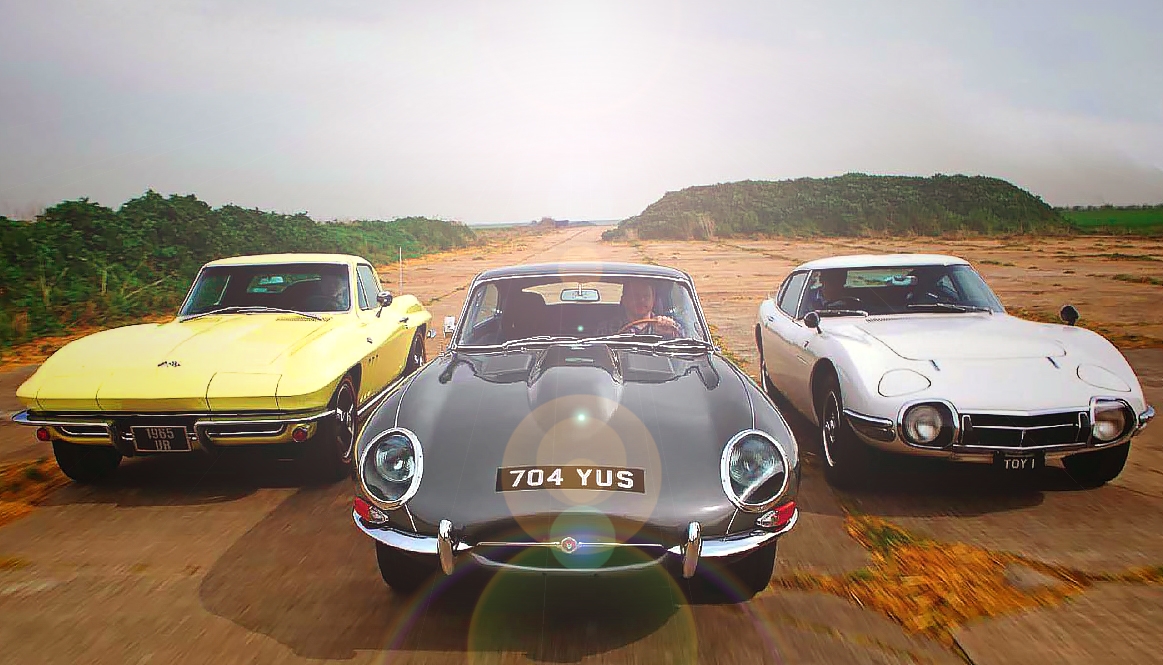
Japan takes on Britain and the USA in our coupe shootout – Tri-Nation great battle. America’s Sweethearts. Jaguar and Toyota did their best to tempt US buyers from their Chevy Corvettes in the ’60s, Alastair Clements finds out how the E-type and 2000GT stand up to the mighty Sting Ray. Photography Julian Mackie. As the post-war austerity of the 1950s brightened into the free-living, free-loving ’60s, journalist Hans Juda’s famous warning to British industry was – happily – receding into history. But the shift in focus that it had created, and the rich rewards it yielded when a smash hit was recorded in the all-important US market, had stuck: ‘Export or die’ had become ‘Export and thrive’.
America was the difference between success and failure, and few knew that better than Jaguar, whose XK family had mined a rich seam of Stateside sports-car enthusiasm but was getting pretty long in the tooth.
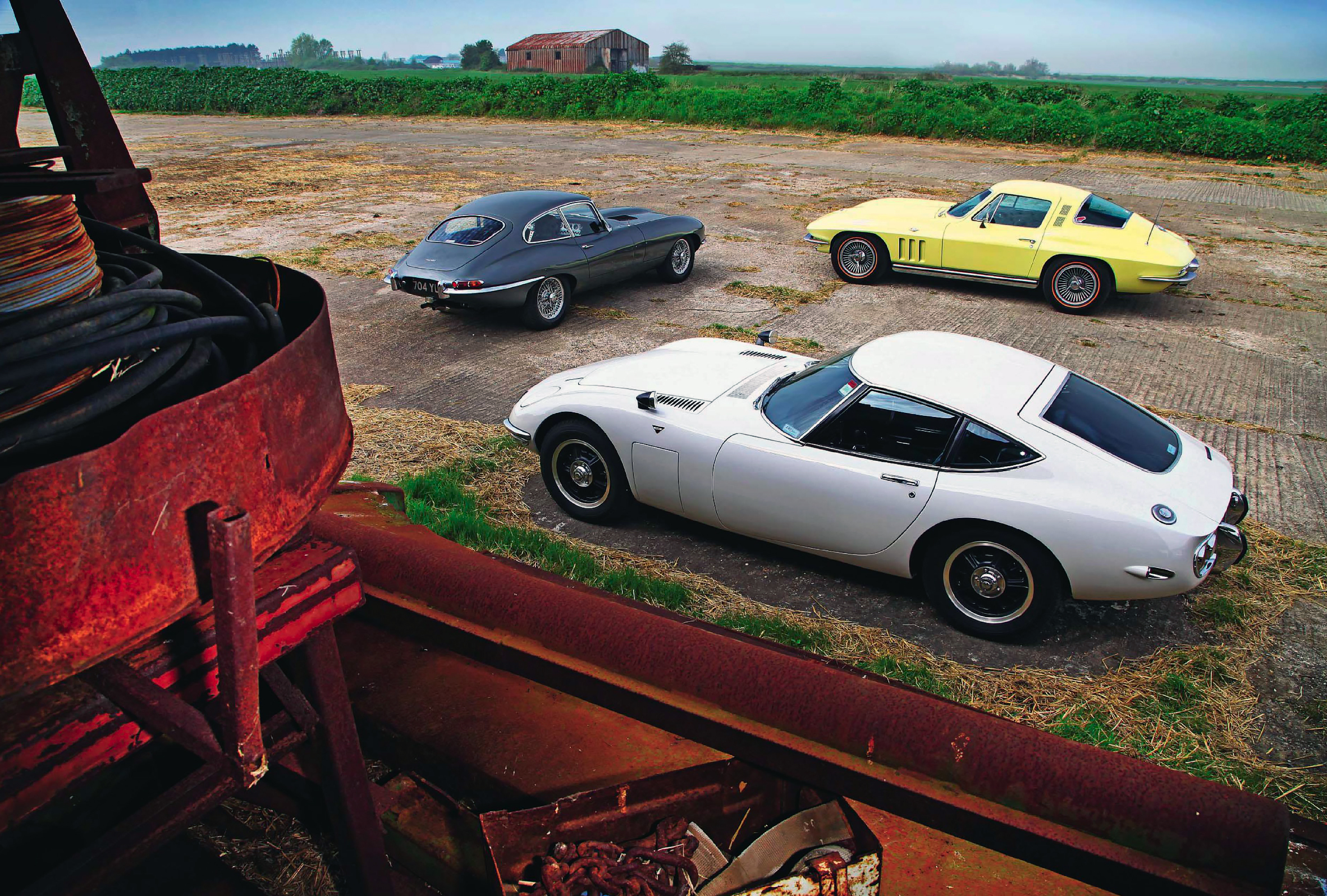
Its answer was the outrageous E-type. Today it seems a machine symbolic of British traditionalism, but at launch in 1961 this iconic car’s overtly suggestive styling, rocket ship performance and almost unfeasibly low price-tag made for a breath taking combination. And, of course, the dollars soon began flooding in…

Japanese manufacturers must have looked on with envy at the ship-loads of ‘XKEs’ sailing across the Atlantic to bask in the California sun. Chances of similar cargos crossing the Pacific seemed rather less likely. Although its products were becoming increasingly capable, Japan had yet to earn a reputation for its automotive industry in the Land of the Free – and there is no getting away from the fact that Pearl Harbor was still too fresh in the memory for many to forgive and forget. Undaunted, Toyota began a new assault on the American market and by the middle ’60s it was second only to Volkswagen among foreign car importers. What it lacked, however, was a true flagship, a halo model to add gloss to its more commonplace Coronas and Crowns. Hence Project 280A, a fabulous hand- built coupe launched to ecstatic crowds at Tokyo in 1965 as the 2000GT, and benchmarked against – some suggest copied from – the best that Europe had to offer.
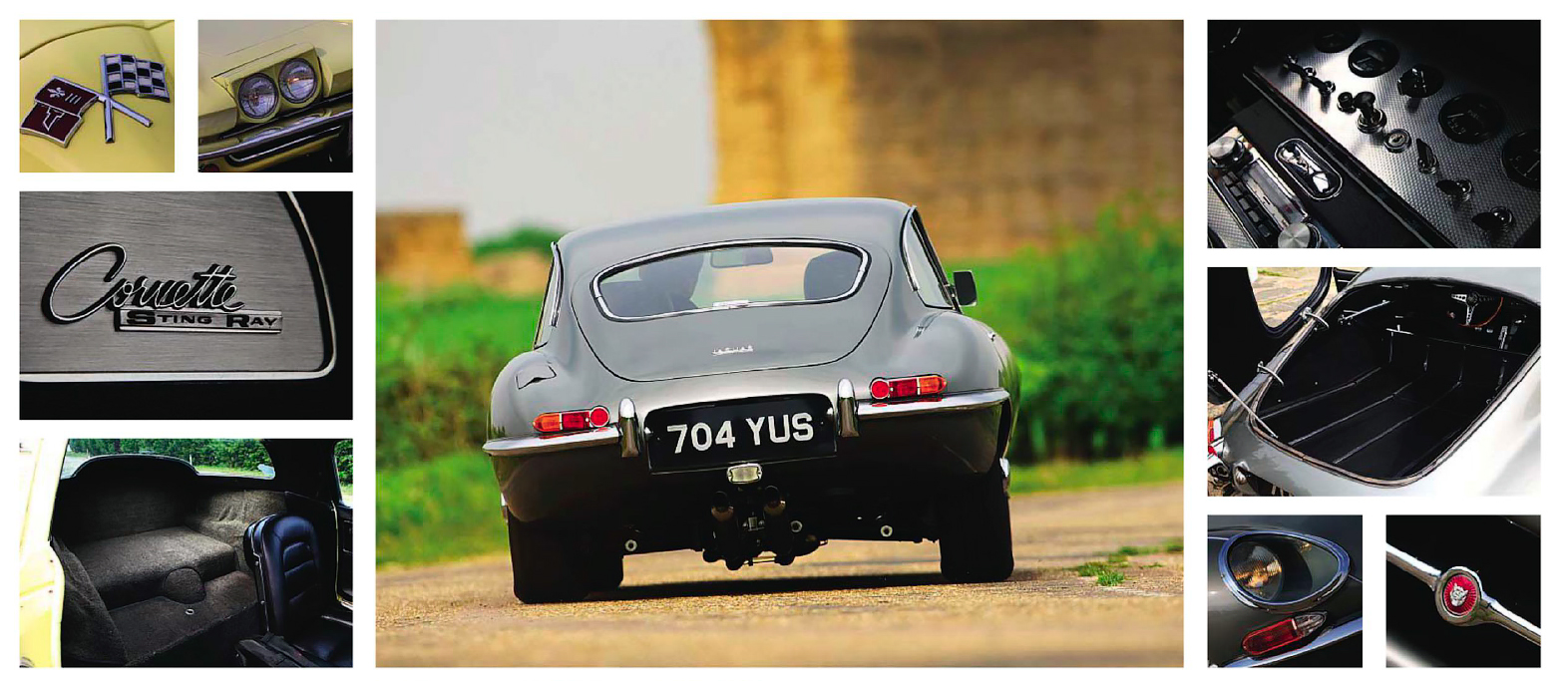
Clockwise, from main: stiffer suspension and wider tyres transform the E-type’s handling; stylish dash; luggage bay is nicely trimmed but not very big; early cars cowled lights; lovely wood-rim wheel
With hindsight, you might argue that the fact that just 62 of the 337 examples built went to the USA suggests that America wasn’t the 2000GT’s key target, but Toyota’s ambitions were clear in its projections of 1000 cars per year. If further proof were needed, it also bankrolled a Shelby-backed SCCA onslaught, with the 200bhp racers taking four wins in their first – and sadly only – season. And while everyone who was anyone coveted an E-type, Paul Newman – a man capable of out-cooling the ‘King of Cool’ – tried to buy the Toyota 2000GT New York show car.
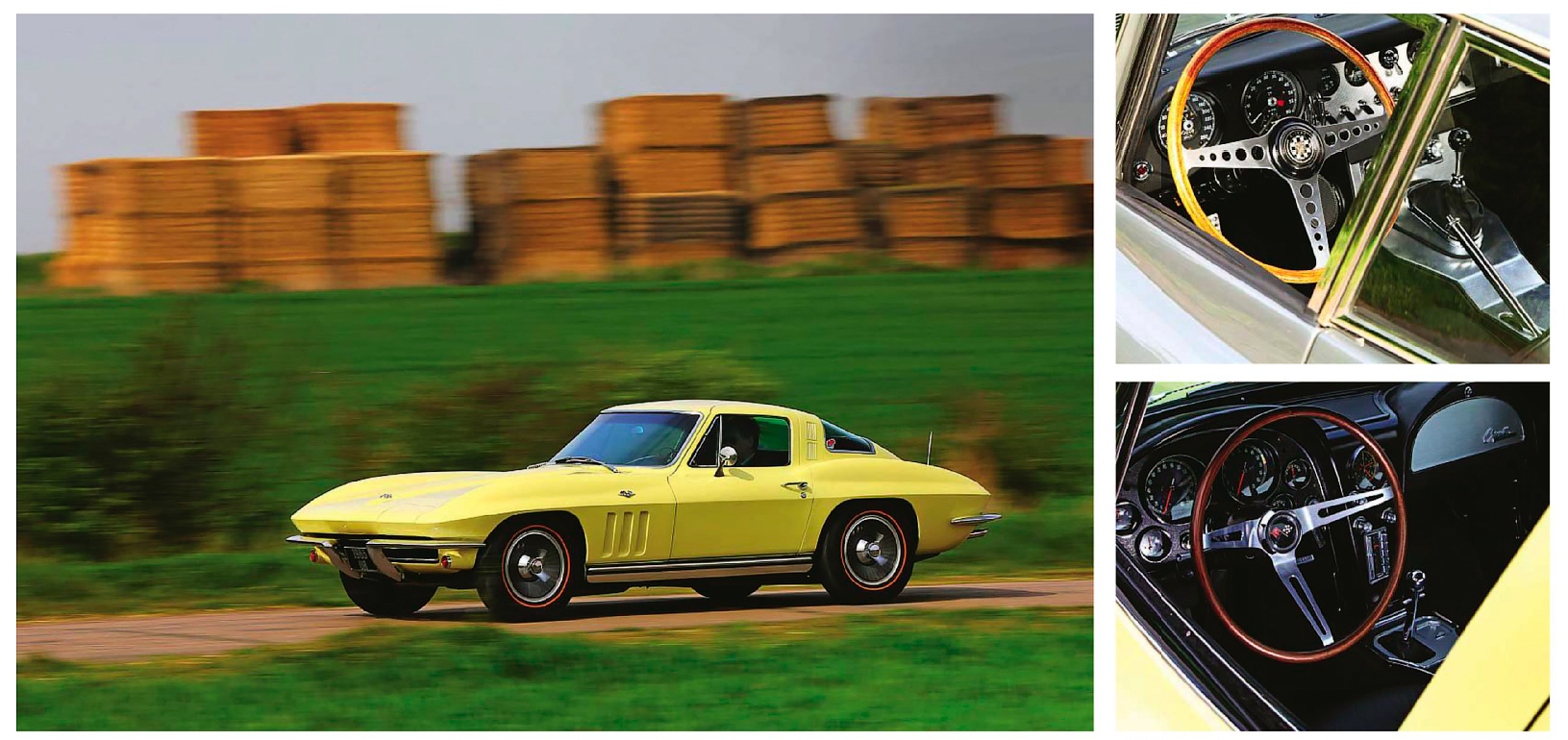
From top: crossed flags imply a racing heritage that the Corvette had to earn; rotating light pods; Sting Ray arrived in ’63; huge load area; stunning shape. Below right deep-dish wheel in funky cabin.
There was a problem for both Jaguar and Toyota in this high-yielding market place, quite apart from any prejudice or import taxes, of course. And that was the small matter of the Chevrolet Corvette, ‘America’s only sports car’, which was relaunched in 1963 as the Chevrolet Corvette C2 Sting Ray in convertible and sensational fastback form. Not that the formula was much altered, apart from engineer Zora Arkus-Duntov adding a transverse leaf spring in place of the C1’s live rear end. Beneath the crisp glassfibre lines – created by stylist Larry Shinoda under legendary design boss Bill Mitchell – was a revised and robust steel separate chassis, plus a selection of V8 engines in various states of tune (14, in fact, over the life of the C2). And it would continue like that – with a bewildering array of specification changes that makes it almost impossible to value a car today without a deep knowledge of the options list – until 1967 and the debut of the ‘Coke-bottle’ C3 Stingray (note one word, not two).

From top: Sting Ray has little roll but the light steering doesn’t offer much feedback; stonking pace from the Jaguar’s big XK straight-six; eager little Toyota has a huge appetite for corners.
Graham Crook has dreamed of owning a Corvette since he left school, the same year that the original Corvette C2 was launched. “I had a poster of a ‘split-window’ on my wall,” he explains, “but I waited a long time to buy because it had to be the right one. I wasn’t worried about which engine it had, but I didn’t want an auto and it had to have disc brakes and power steering – which is why I went for a ’65.” Some 18 months after he picked up his fabulous yellow 327/300 from Kent specialist Claremont Corvette, the reality has more than lived up to the dream – and it’s easy to see why. It’s fashionable for European hacks to dismiss the Corvette as a sports car suitable only for straight roads and drag-strips but, while there is an element of truth in that, it’s also worth remembering that this car has an impressive spec for 1965 that encompasses all-disc brakes, power steering and all-independent suspension.
It also looks simply superb, blending the remnants of the American ‘jet-age’ obsession with an aggressively wedgy profile that hints at ’70s styling trends with its pointed snout, pop-up headlamps and surprisingly minimalist use of chrome. It’s all beautifully set off by the replica Kelsey-Hayes turbine-style alloys.

From top: Kelsey-Hayes alloys are replicas of valuable period option; traditional wires for Jaguar; Toyota swapped Borranis for magnesium alloys for production. Left: stylish cabin is a special place to be.
Despite Chevy advertisers’ proclamations, you didn’t need to be a ‘red-blooded American male’ to enjoy a ’Vette by ’65: the clutch is light, the gearshift easy and surprisingly slick, the steering wildly over-assisted so that any feel is well masked. Only the unservoed discs need a bit of muscle, though they work well enough.
On a rough airfield perimeter route there’s no disguising the fact that this is a separate-chassis machine as it hops, skips and clonks along, but once onto the smoother local roads it feels much happier. There isn’t much body roll and, though a bit soft and loose at the back, it grips reasonably well on its 205/75 R15 Coker Classics – or, as a typically effusive ’63 Road b Track test put it: ‘In a word, the new Sting Ray sticks.’
It’s certainly more agricultural than its rivals, but if you try your best to forget the ‘sports car’ or ‘muscle car’ tags and instead think of it as a bargain alternative to the classic Euro-GT it makes more sense. Ahead there’s a wonderful view down the big central bonnet bulge, with the sharply creased wing-tops making it easy to place even on narrow roads. Inside, it feels hugely roomy, with a massive boot accessed only from within. It’s just a shame that the interior finish lets down that GT feel. It looks pretty special, with its deeply dished faux-wood three- spoke wheel fronting a stylish double-binnacle dash, but it’s cheapened by the use of brittle black plastic livened by flashes of chrome.
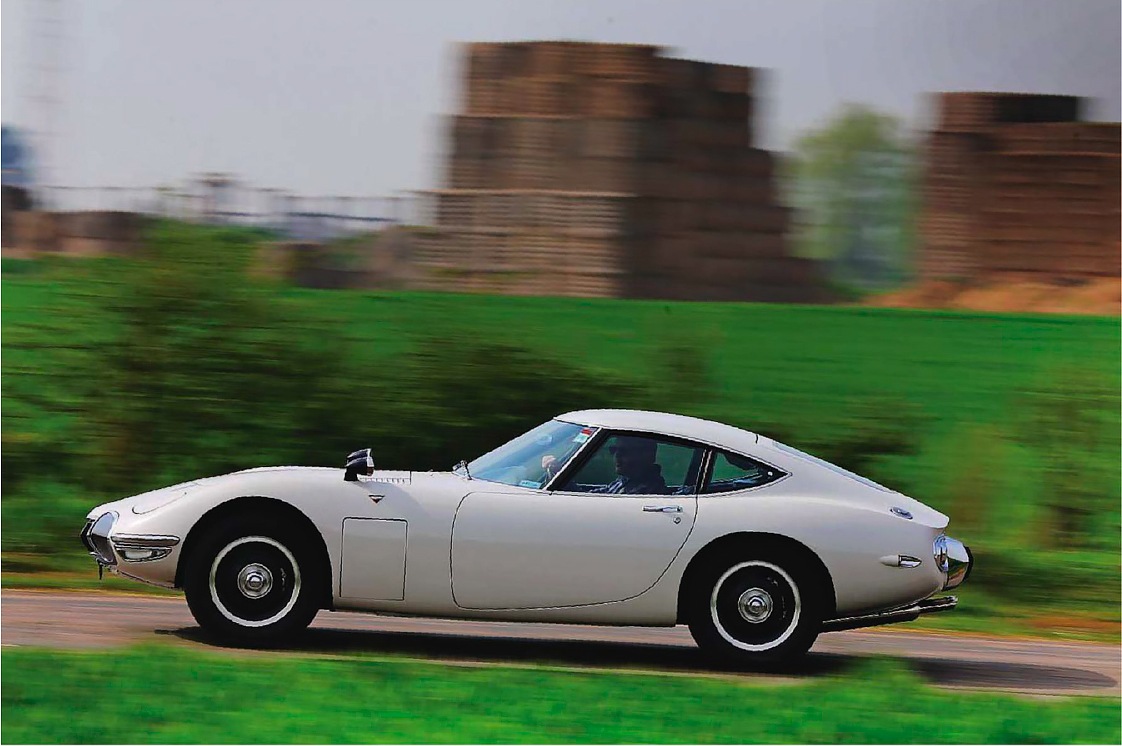
Black trim and sharp lines give a more modern look than the Jaguar. Neat wing lockers house battery and air filter. Below: pop-ups for US law; cosy cabin with slender, Elan-style seats; superb build quality inside.
You only have to start it up to forget all of that. The L75 ‘Turbo-Fire’ 327 was the second lowest of six engine outputs offered for ’65 – up to 425bhp was available in evil-handling big- block form – yet at 300bhp it’s still the most potent car here and has more than enough to raise a smile with just a prod of the throttle. There’s never any need to trouble the 5000rpm start of the redline, because it seems to give the same great gobs of grunt wherever it is in the rev range. No fuss, it just ups and goes: none of your highly strung specifications, but lots of cubes and a good ol’ V8 soundtrack- not the rumbling thunder of a big-block, but a freer yet still meaty thrum – and so much torque that you can just stick it in fourth and leave it there unless you need to stop. It’s simple, uncomplicated fun, the same recipe that has now served Chevrolet’s flagship faithfully for more than 60 years.
If the Corvette wants for sophistication, the Jaguar E-type has it in spades. And that begins from the moment you set eyes on the car, which for me has always been far prettier in SI fixed- head coupe form than as the more showy roadster. The combination of Jaguar boss William Lyons’ immaculate eye for line and Malcolm Sayer’s aerodynamic nous created a wind cheating shape with real voluptuous beauty. It’s one whose impact is perhaps dulled slightly by familiarity, but it’s hard to underestimate the knockout punch it must have had when the covers came off at Geneva in 1961.

Beneath those super-smooth lines, the sense of greater design integrity extends to the engineering: it’s a modern monocoque, for a start (albeit one with a tubular subframe bolted onto the front to carry the engine and front suspension), with twin-cam straight-six power, all-independent suspension… the list goes on. Yet there are anachronisms: until the 1964 arrival of Jaguar’s own gearbox and a larger 4.2-litre engine, the 3.8 was lumbered with an aged Moss four-speed transmission with no synchromesh on first. Not that anyone had bothered to look at that part of the specification sheet: few could get past the performance figures. They might have been achieved with a coupe that had been prepared as something of a ‘road test special’, but 0-60mph in just under 7 secs and 150mph flat-out was almost unbelievable for a road car that was affordable to the merely wealthy rather than the hyper-rich.
Jaguar’s advertising was suitably confident, calling its new offering: ‘The most advanced sports car in the world.’ Bullish, yes, but also realistic. Once it had got its de rigueur sexist comment out of the way- ‘The greatest crumpet collector known to man’ – Road b Track gave a glowing verdict: ‘The ultimate in performance, matched by superb road holding and braking, at a remarkably low price.’
This particular 1963 E-type is a bit special, having been thoroughly reworked by the magicians at JD Classics’ Maldon headquarters. As a result, it feels rather different to a standard car, from its modern seats to its smoothly assisted quick-rack steering, huge brakes, stiffer suspension, wide tyres and five-speed (Toyota) gearbox. All of which means that the majority of the Jaguar legend’s flaws – and it does have them, contrary to what blinkered worshippers might have you believe – have been ironed out.
The steering rack’s slight stiffness is gone, happily without losing its fluidity; likewise, the standard car’s tendency to feel a little tip-toed in corners has been eradicated, yet it’s just as supple. Fortunately, enough of the original character shines through – in part thanks to that cramped yet charming cabin, with its familiar dials and toggles across the dashboard. Although it’s the same length as the Corvette, the Jaguar is also more than 4in narrower and its low roof- line further constrains interior space.
But of course the one element that defines the character of an E-type, that is almost impossible to disguise, is that amazing XK engine. Even in smaller 3.8-litre form, the twin-cam ‘six’ is unbelievably flexible, as happy lugging from low revs as it is spinning right out to give its best in the upper reaches of the rev range. And boy is it quick! All the while delivering a wonderful selection of evocative sounds that conjure images of its endurance-racing C- and D-type brethren that brought the marque such success at Le Mans and around the world.
No wonder the Toyota team seconded to Yamaha brought in an E-type to see how its new 2000GT measured up. That and a Lotus Elan, of course, and DNA from both can be traced in the car’s two main components: the chassis, which mimics the classic Lotus backbone, and the shape, which is like a five-sixths-scale version of Jaguar’s masterpiece. The styling is often credited to Count Albrecht von Gortz, whose A550X Nissan concept car was a contemporary project at the Yamaha works. But while that may well have been an influence, the 2000GT’s bold style was the work of Satoru Nozaki.
In the best Japanese tradition, the Toyota ‘borrows’ cues from other cars and refines them into a cohesive new whole, only marred by a slight fussiness to the front end thanks to the extra pop-up lamps added to comply with Federal height regulations. Look around and you’ll spot inspiration from the BMW 507 in the black knock-on magnesium alloys, Maserati in the crisp line around the tail, the C1 Corvette in those tiny rear-wing lamps and Zagato’s famous ‘double bubble’ in the roof.
Pull the deliciously delicate bespoke handle, swing open the door – with its upswept rear edge designed to avoid clouting it on kerbs – and, if like me you’re over 6ft tall, you soon see why Sean Connery needed the roof to be lopped off his 2000GT for its starring role in You Only Live Twice. It’s very cramped. But even with knees jammed up against the under-dash switch panel – with its elegant knobs that look like typewriter keys – it’s worth making the effort, because the interior is fabulous. There are some cheaper touches such as the heat-formed faux stitching in the vinyl, but the slender Elan-like bucket seats are comfortable and ahead there’s a wraparound windscreen so curved that it’s like looking out of a motorcycle visor, Stratos-style.

Toyota 2000GT – road-test
In restoring this car, JD Classics tried to retain as much of the original cabin as possible and it’s a joy to look at the slender Rosewood veneers – Yamaha also made pianos, remember – and funky detailing, from the Ton Tun radio, via the square Jeco clock and stopwatch to the sweeping door cards, each with their own cigarette lighter and ashtray: a particularly neat ‘GT Man’ touch.
Turn the key and the first thing to strike you is that the 2000GT is just so… Japanese. It fires first time, ticks over with absolute serenity and picks up cleanly with every blip of the throttle. Although it gives away nearly 2 litres in capacity to the E-type, at lower revs it has surprisingly similar straight-six bluster – a result, presumably, of the same twin-cam layout. The stubby mahogany-topped gearlever needs a firm hand, but the homegrown five-speed ’box is precise and positive – and as soon as you get it stoked up the engine takes on an entirely different character, eagerly zinging towards its 7000rpm redline with the same reliable, free-spinning feel as a Japanese-made drill. The iron block’s humble origins in the Toyota Crown are brilliantly disguised by the Yamaha twin-cam big-valve hemi-head and, despite conceding over 100bhp to the E-type, it feels little slower- and certainly quicker than the performance figures suggest.
Much of that is because the car feels so alive. The steering isn’t light, but it’s super-responsive and sharp, matched to a chassis that mimics the Elan in its agility and precision. The ride is good yet there’s little roll and no hint of understeer, and the narrow track and slim 165 SR15 Michelin XZXs mean that oversteer will soon catch out the unwary if you back off mid-corner.
In short, it’s the only car here that feels like a sports car. Unfortunately, it’s also by far the most expensive. When we last drove a 2000GT (in 2007), it was valued at around £150k; today, it’s a million-dollar car. Which means that in the ‘which one would I have?’ battle, it prices itself out of contention to mere mortals.
Although it was brought to life as a response to the success of British designs, the Corvette’s blend of style, sound and character endeared it to millions, and its crossed-flag badges and orange- painted V8 have become as much a part of US culture as burgers and rock ’n’ roll. And if that’s your taste rather than fine dining, it’s easy to see why you might pick one over an E-type. But there is a good reason why the Jaguar is the default dream car for enthusiasts the world over: fast, beautiful and usable – it has it all.
You can’t help wondering, however, whether the GT might have been a success had Toyota managed to keep the price down to E-type levels – or, better still, to match the Corvette. Because even as a hand-built exotic it was a warning shot across the bows, one that helped lay the foundations for what was to follow. Hot on its heels came the Datsun 240Z, an affordable sports car that US buyers took to their hearts, and as Detroit foundered Japan began to dominate. And what is America’s best-selling passenger car today? Why a Toyota, of course.

Top, left to right:’ Vette came with an array of V8s; 3.8 has same power as 4.2, less torque; Yamaha twin-cam is a jewel – last seven GTs had a single-cam 2.3.
| Car |
Chevrolet Corvette Stingray C2 |
Jaguar E-type S1 FHC 3.8 |
Toyota 2000GT |
| Made as | USA | GB | Japan |
|
Sold |
1963-1967 | 1961-1968 | 1966-1970 |
| Number built | 45,546 (all coupes) | 15,439 (all FHCs including “S1 ½” models) | 337 |
| Construction |
steel perimeter frame chassis, glassfibre body with steel inner structure |
steel monocoque with tubular front subframe |
steel backbone chassis, steel semi-unitary body |
| Engine |
all-iron, ohv 5356cc V8, four-barrel Carter AFB carburettor (L75 ‘327/300’ spec, as tested) |
iron-block, alloy-head, dohc 3781/4235cc straight-six, triple 2in SUHD8 carburettors | iron-block, alloy head and sump, dohc 1988cc straight-six, triple twin- choke Mikuni-Solex 40mm carburettors (last seven ‘S2’ cars with single-cam 2.3-litre ‘six’) |
| Max power | 300bhp @ 5000rpm |
265bhp @ 5500rpm (3.8) |
150bhp @ 6600rpm |
| Max torque | 360lb ft @ 3200rpm | 260lb ft @ 4000rpm | 130lb ft @ 5000rpm |
| Transmission | all-synchromesh four-speed manual, driving rear wheels |
Moss four-speed manual, no synchro on first (all-synchromesh for 4.2), driving rear wheels |
all-synchromesh five-speed manual (optional automatic on final S2 cars), driving rear wheels |
| Suspension |
independent, at front by unequal-length wishbones, coil springs, anti-roll bar rear transverse leaf spring, lower links, trailing arms; telescopic dampers f/r |
independent, at front by double wishbones, coil springs, telescopic dampers, anti-roll bar rear lower links, drive shafts as upper links, twin coil/ damper units |
independent, by double wishbones, coil springs, telescopic dampers, anti-roll bar f/r |
| Steering |
recirculating ball, with optional power assistance |
rack and pinion |
rack and pinion |
| Brakes |
All Discs |
All discs, with servo |
All discs, with servo |
| Measurements |
Length 14ft 7in (4450mm) Width 5ft 6in (1765mm) Height 4ft 1 3/4in (1264mm) Wheelbase 8ft 2in (2490mm) |
Length 14ft 7in (4450mm) Width 5ft 5 1/2in (1660mm) Height 3ft 11in (1190mm) Wheelbase 8ft (2440mm) |
Length 12ft 10 1/2in (3924mm)
Width 5ft 3in (1600mm) Height 3ft 9 3/4n (1161mm) Wheelbase 7ft 7 3/4n (2330mm) |
| Weight | 3050lb (1383kg) |
2650lb (1202kg) |
2560lb (1161kg) |
| 0-60mph | 7.5 secs |
6.9 secs |
10.0 secs |
| Top speed |
124mph |
150mph |
130mph |
| Mpg |
14.8 |
17.9 |
– |
| Price new |
$4353 |
$5580 |
$7250 |
| Price now |
from £40,000 |
from £45,000 |
from £500,000 |
Thanks to Derek Hood and Alex Newman at JD Classics (01621 879579; jdclassics.co.uk); Graham Crook; Tom Falconer at Claremont Corvette (01634 244444; claremont.corvette.co.uk); Richard Falconer and Tim Hinds.





